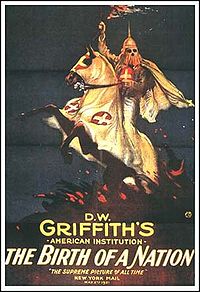Birth of a Nation: Difference between revisions
No edit summary |
No edit summary |
||
| Line 3: | Line 3: | ||
====Region: [[:Category:North America|North America]]==== | ====Region: [[:Category:North America|North America]]==== | ||
====Subject: [[:Category: | ====Subject: [[:Category:Political/Economic/Social Opinion|Political/Economic/Social Opinion]]==== | ||
====Medium: [[:Category:Film Video|Film Video]]==== | ====Medium: [[:Category:Film Video|Film Video]]==== | ||
| Line 30: | Line 30: | ||
[[Category:North America]] | [[Category:North America]] | ||
[[Category:United States]] | [[Category:United States]] | ||
[[Category: | [[Category:Political/Economic/Social Opinion]] | ||
[[Category:Film Video]] | [[Category:Film Video]] | ||
[[Category:D.W. Griffith]] | [[Category:D.W. Griffith]] | ||
Revision as of 16:05, 11 November 2016
Date: 1920
Region: North America
Subject: Political/Economic/Social Opinion
Medium: Film Video
Artist: D.W. Griffith
Confronting Bodies: Citizens
Dates of Action: 1920
Location: United States
Description of Artwork: The silent film, Birth of a Nation. "The story fell into two parts: The first is a conventional enough narrative of the Civil War; the second is a view of postwar reconstruction as seen very much from a native Southerner's point of view.The story forsook narrative for controversy when it portrayed every black as animalistic, moronic and lusting after women, while the overtly racist Ku Klux Klan appeared not only saviors of the South but of the North as well." Jonathon Green, The Encyclopedia of Censorship, Facts on File, pg. 21
The Incident: The film "...was banned in more than a dozen localities ( and furthermore has been the most banned film in American history) because of its white supremacist sympathies, racist stereotypes, and glorification of the Ku Klux Klan..." Sex, Sin, and Blasphemy, Marjorie Heins, pg. 40
Results of Incident: The NAACP continues to fight against it.
Source: Sex, Sin and Blasphemy, Marjorie Heins, New Press,'93, NYC
